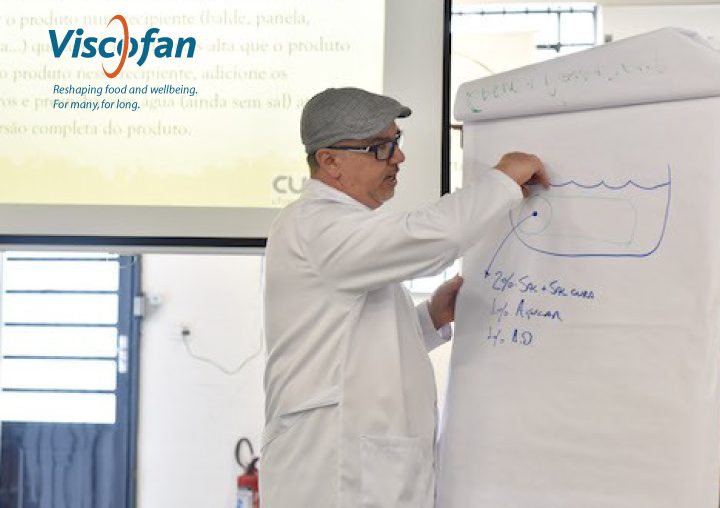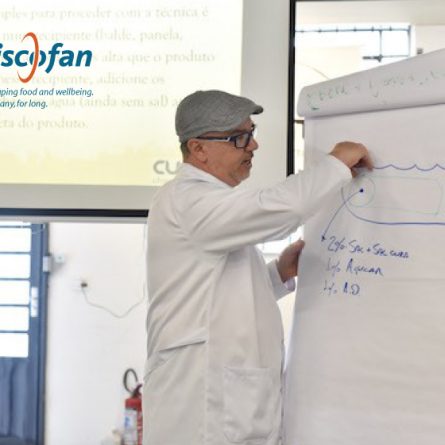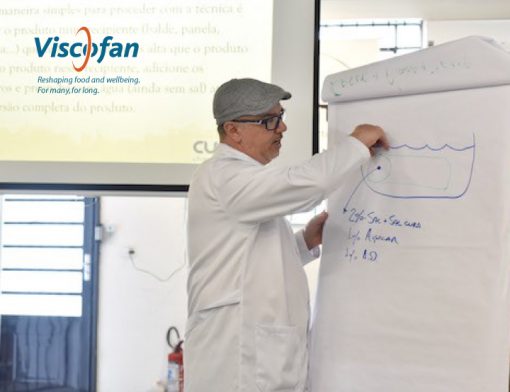Navarro believes product quality and supply should be improved through learning experiences and campaigns
By Patrick Parmigiani, 2/23/2021
Our exclusive interview with master charcutier Edson Navarro continues in this second and final part. Navarro is the co-founder of Curato Charcutaria Artesanal, the first charcuterie school in Brazil, and is also the president of the Charcuterie Association of São Paulo (APAC). This second part discusses the raw materials related to pork available in Brazil, the new federal law for “Selo Arte” seal granting, and more. You can read the first part of the interview here.
CarneTec: While Europe has a large variety of meat products in gondolas, Brazilian meat is limited to top sellers with little room for innovation. What has the meat industry been doing to change this?
Edson Navarro: I am aware that current context of industrial charcuterie has made a few minor changes when it comes to the products we can find in supermarkets, but the situation is still far from ideal. There aren’t that many products in premium categories, so to speak. Since we’re still in a pre-discovery phase for charcuterie, I believe there aren’t enough people willing to accept high-quality charcuterie products, and for this reason, there’s little product variety in supermarkets besides imports.
Sophisticated charcuterie is a niche market. Its target audience is demanding, including people who traveled to Europe or are descendants of Europeans, or even people from high-class gastronomy backgrounds. They can tell what makes a high-quality product and they seek these products out. To give you an idea of this difference, Italy has over 700 different types of salami, including industrial, regional, and hand-crafted. If you put products from other countries into the equation, like Spain, France, Portugal, etc., you can find thousands of different products.
Changing the subject to another aspect of the production chain, does Brazil have a high enough variety of pork (i.e.: breeds, different farming methods) to fulfill the needs of craft charcutiers?
Unfortunately, no. Brazilians are experts when it comes to bovines. Nowadays, you can easily talk to someone over a barbecue and overhear people talk about bovines like red or black angus, nelore, etc. They are aware of cuts with unusual names like flat iron or brisket. When it comes to pork, though, people barely know what a coppa cut is. And things are even worse when it comes to breeds. One of the most well-known breeds in charcuterie is the duroc. Very few people know this breed or any other breeds, including the most commonly raised ones in Brazil, landrace and large white.
There are many problems in finding raw materials for charcuterie, since breed and meat quality directly influence the products’ final characteristics. The bovines available in most meat stores are meats targeting end consumers. People looking to fry or cook their meat right away. The characteristics of these meats do nothing but create more problems for our work. They have low fat with small cuts and, for the most part, they aren’t the best for high-quality charcuterie.
The whole problem starts with breeds, and improper handling can increase stress in livestock and change the meat pH. Livestock is raised under strict dietary controls so that they are not fat, allowing them to be slaughtered at low weights (around 80 kg). The truth is, over the years, we’ve changed livestock’s genetics, which resulted in the weaker breeds you see today. Animals are getting sick more easily and have to be given antibiotics frequently. This combination of factors leads to raw materials that are far from ideal for charcuterie.
Our livestock must be above 200 kg and rich in intramuscular fats, on top of being from good breeds. Raw ham, ready for consumption, for example, weighs around 10 kg. This means that in natura ham should weigh at least 20 kg, since there’s a loss of around 50% of liquid to take into account.
Consider the fact that producing raw ham requires at least one year of drying. If our raw materials aren’t good enough, that means we’ve wasted the whole year as well as the expenses set aside for the process. Today, the supply of high-breed pork with proper weight is extremely rare for high-quality charcuterie in Brazil. And prices are, on average, three times the price of commercial pork. All of this contributes to making production in small-sized charcuterie businesses more difficult.
As a charcuterie enthusiast, what are your dreams and what role should each person play for the industry?
Without a doubt, my mission is to spread the art of charcuterie in Brazil and to improve the quality and supply of products through learning experiences and campaigns, so that one day we can be proud of what we produce in our country. Nowadays, there are handcrafted Brazilian beers and cheese winning international awards, but charcuterie is still in its infancy. I want us to run for awards out there with our own products. But we still need a lot of the support to make this a reality.
I founded the Charcuterie Association of São Paulo (APAC) three years ago to spread the word about our work and to provide a unique experience to consumers. It’s all volunteer work without any kind of sponsorship. It’s all made independently. We’ve been putting in a lot of effort to improve engagement, but our numbers are still low.
When it comes to individual roles, I believe the government still doesn’t do enough to support small-sized charcutiers. There aren’t enough incentives and laws are still too strict. Researchers should also approach our cause, though I understand that’s not a priority for them at this time. Large-sized companies would greatly benefit from our work, as we are also researchers ourselves, and we’ve been making a lot of tests in our own handcraft labs. Both consumers and public agencies will only become more closely involved with charcuterie once we’ve spread our work in Brazil, and this is what I consider to be our mission at APAC.
On December 1st, 2020, the Brazilian Ministry of Agriculture (MAPA) began enforcing Normative Instruction No. 61, which regulates the compliance of crafted meat products for “Selo Arte” seal granting. What changes were brought by this new law? Does it fulfill the industry’s demands?
This is another controversial subject... As far as I’m aware, the “Selo Arte” law will only fulfill the demands of producers who already have some kind of inspection seal. In the case of São Paulo, for example, that would be the City Inspection Service (SIM) or the State Inspection Service (SISP). This would impose restrictions on small- and midsized producers who don’t have the necessary inspection seal, due to the complexity of the requirements, especially when it comes to physical infrastructure. No rules have been determined yet for the State of São Paulo, and in this case, none of the products made here bear the “Selo Arte” seal. Other States have made progress, but we still have very few options for products with certified seals.
This law touches on some topics that can be difficult to understand. For example, to earn the seal, a product must have regional characteristics, but when it comes to Brazilian charcuterie, almost none of our products have any “regional characteristics” at all. Brazil lacks any tradition in charcuterie. Most of our products are made resembling European products.
Ultimately, authorities need to better understand this new generation of small businesses. Ours is a generation that can be self-proclaimed “urban charcutiers”. Many of our products are made in the city, and our raw materials are inspected by sanitary agencies accordingly. We don’t raise pork and we have no intention to do so. Our manufacturing style closely resembles industrial kitchens. It’s all made in a small, clean space that observes the best manufacturing practices and flows.
Despite these challenges, are you optimistic for 2021? Do you think there’s a market for all budgets and tastes?
Yes, I think this is a very promising market with an increasing number of opportunities. We are very optimistic about 2021 and the growing demand for high-quality goods.
Would you like to leave a message or invitation to readers of CarneTec?
First of all, I would like to thank you for letting me show my point of view about our situation. I want to congratulate you for taking the initiative to hear from small- and midsized producers, too.
If you’re looking to learn more about Curato Charcutaria, please visit www.curato.com.br. You can also find us on social media: @curatocharcutaria
Or you can learn more from the Charcuterie Association of São Paulo (APAC) at https://www.apaccharcutaria.com/ and on social media: @asspac



